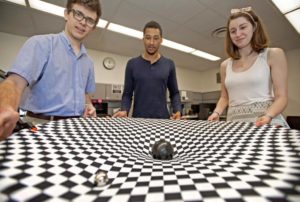Gravitational Waves
 Gravitational Waves – Cypress students involved in groundbreaking research
Gravitational Waves – Cypress students involved in groundbreaking research
The impacts of stars colliding into one another in the far depths of space, collapsing into black holes billions of years back can now be detected (and Cypress students played a part in the discovery!). This is a momentous breakthrough for physics; one that confirms Albert Einstein’s abstract, 100 year old intuition that gravity is impacted – though on an exceptionally small scale – by galactic events.
Like ripples on a pond, these cosmic excitations pool into our universe and traverse the cosmos as gravitational waves, bending both space and time in their travels. The impact had on our so-called reality is imperceptible… so extraordinarily small and subtle that Einstein himself couldn’t imagine we would ever have the capacity to detect their existence.
As of this year we do. Decades of research, billions of dollars in funding, tens of thousands of scientists from around the globe have developed two Laser Interferometer Gravitational-Wave Observatories (LIGO) located here in the U.S. (Livingston, LA and Hanford, WA), equipped with an instrument sensitive enough to measure gravitational waves.
Taking part in the cutting-edge research are two Cypress College scholars: recent graduate Eric Muniz and current Physics student Sam Rodriguez (Cypress College, Class of 2016). Through our STEM^2 Program’s summer research partnership with Cal State University, Fullerton, both Eric and Sam participated in theoretical modeling at CSUF’s Institute of Gravitational Wave Physics and Astronomy. Eric, for example, joined a team working in optics experimentation and scattered light characterization. In follow-up, both have chosen to continue their undergraduate studies at the Institute, working alongside renowned faculty like Assistant professor of physics Geoffrey Lovelace, a Ph.D. graduate of Caltech (and former student of legendary Nobel prizewinner Richard Feynman!) who has dedicated his career to studying the extreme space-time around black holes using supercomputers.
We are pleased and proud of Eric and Sam and wish them the very best in their future scientific pursuits. For us, it’s pretty awesome that in some small way our institution – via their contributions – is tied to this tremendous scientific discovery.
